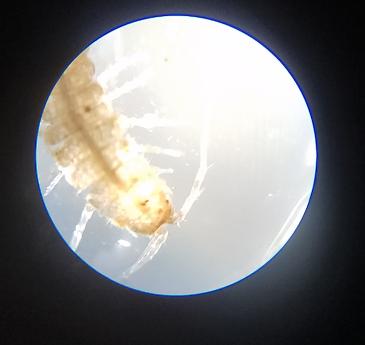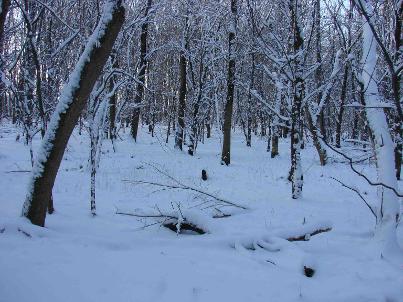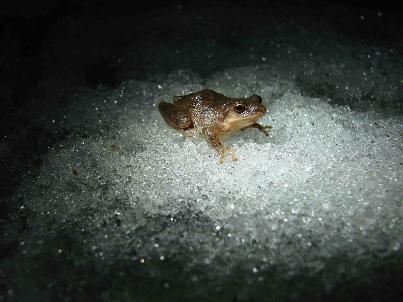What is a Vernal pool??
Vernal pools are seasonal wetlands that dry up (or draw down) most years or every other year. In short, a vernal pool fills with spring rains and snowmelt only to dry up later in the year. There are many variations of vernal pools, but all should meet these two criteria: they cannot contain fish, and they should completely (or mostly) dry out by summer’s end.
They hold a diversity of life and a cacophony of sound in this mini ecosystem. This website has some of my observations, photos, and videos. The dates reflect the day of exploration, not necessarily when I posted them. Enjoy! -David R. Celebrezze
Entry #1 #2 (2022-2-19)
I'm back! After a few years off I renewed my permit to monitor a couple pools I've monitored in the past. The first time I went out was a couple weeks ago and it was still frozen solid. I went back out last Saturday the 19th and the ice was relenting its icy grip to cold waters of spring. I wasn't able to get to the second vernal pool due to construction going on. I need to go around to the back end which requires talking with a developing/housing/apartment company. Hoping to get that taken care of this upcoming Saturday. But pool A was active. No fairy shrimp but did see spiders, copepods, ostracods, and planaria. Surprisingly no daphnia; maybe this upcoming week.
Ostracod below. I think it is Bradleystrandesia
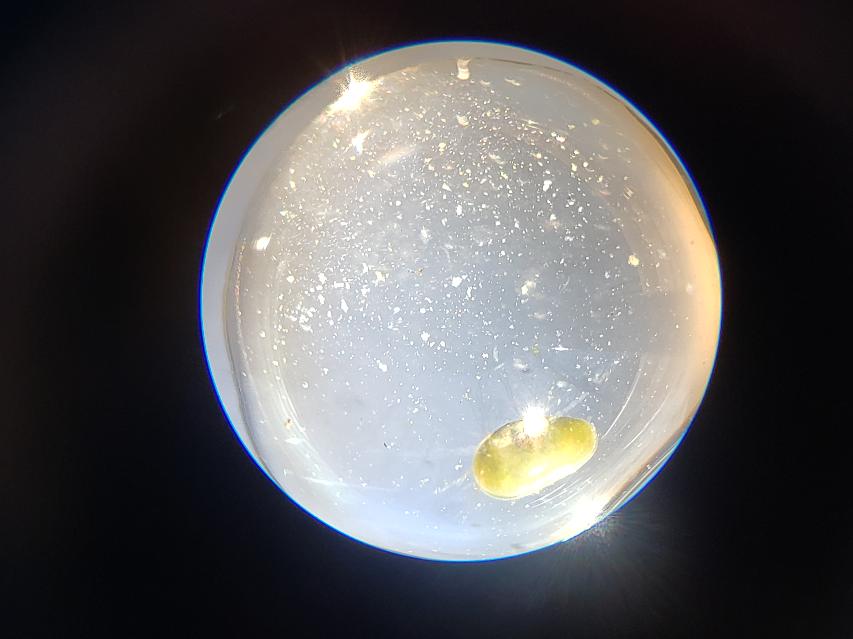
Blurry picture of a copepod below. I ordered a microscope cell phone holder so hopefully it will work.
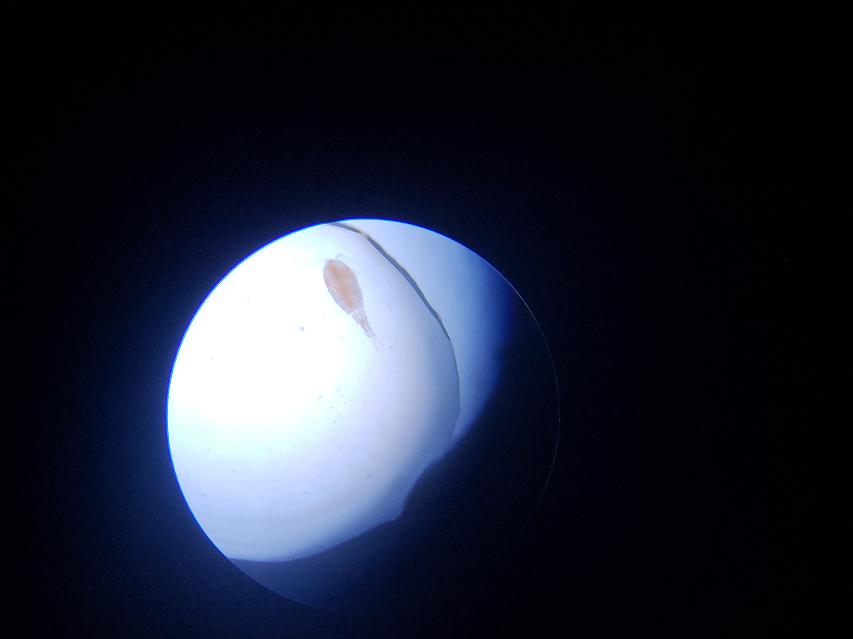
Below is the planaria.
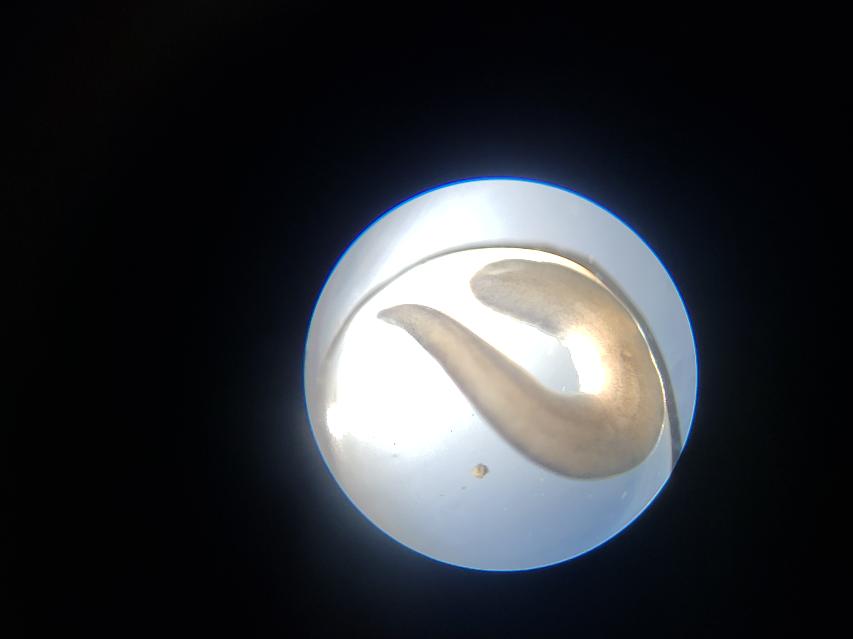
A good night to be out in the darkness. I met up with a couple of friends I hadn’t seen in a while and headed back to the vernal pool. We stopped by the small one first and I was surprised at how many backswimmers there were. Totally insane. Unfortunately, I lost a bunch of pictures from that trip, so I don’t have any to show you. There were 100s. I wonder how that will impact the sallie egg masses and other small macros. Backswimmers are predatory and make no bones about it. We did see a spotted salamander there along with dozens of spring peepers. Speaking of which, in the pools up front there were 1000s of them. The next day I had a pepper, raging headache because I forgot to bring ear plugs. We also heard wood frog, western chorus, and norther leopard frog.
We get to the back pool and the peepers weren’t as loud but still made themselves known. Many egg masses were stumbled upon as well as more than a dozen spotteds. What worries me about this pool is the number of green and bullfrogs that are present. These species can decimate a spotted’s egg masses. I’ll be talking with the property owner to see if we can’t relocate them somewhere.
After a good while we head back to the car. A long hike, but the adrenaline of seeing part of the migration makes it less of a burden. A barred owl and great horned owl meet us in the parking lot. I couldn’t get a picture of one, but it was hella cool.
Entry #2 (2019-3-10)
Back at it. This time I lead a morning trip with three folks. Good conversation, good weather, and good sitings. We had a couple of people cancel but that’s ok. As we walked the mile journey to the back pool we talked about the history of the location, birds (plenty of spottings), vernal pools in record time.
We first hit the smaller of the pools. Frozen. I would have thought our yo-yo weather would have meant an ice-free pool. I was wrong. We were able to punch through some of the ice to get samples. We saw the copepod that was ready for St. Patrick’s Day. There are more than 5,000 species of copepods in the world; you won't find that many in Ohio vernal pools which makes it so much easier to identify them. I believe this one is a cyclops (cyclopoids) with two egg sacs. The vernal pool we were at probably had about a million of these friends.
We spot a small red line that isn’t moving. On further inspection under the microscope we find our pal Chironomid midge (your author always has trouble pronouncing this word—chironomid that is). When larger they spaz through the water in a figure 8 movement. Fascinating to watch. They are red from a hemoglobin-like pigment. This one was tired so we put him/her back. We make it to the back pool and were able to break the icy seal. One in our group sees the invisible—a phantom midge. They are aptly named because they are almost 100% translucent. A killer of mosquito larva and friend of humans, the midge’s antennae developed into almost hooks in which it grabs its prey and enjoys a meal.
Next on the hit parade are daphnia. Ever present, I view them as a gentle macro that would hug you if it could (unlike giant water bug which would stab you). They give birth to live young that look just like the adults.
After about 3 hours we make it back to the cars where a couple of juvenile bald eagles fly overhead. A fitting way to end a great trip to a vernal pool.
Chironomid midge in slumber state.
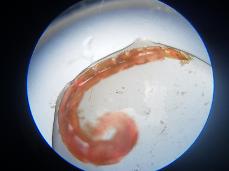
Copepod on the move.
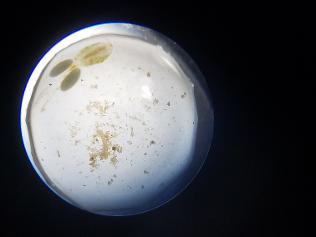
Phantom midge--look at those antennae/hooks!
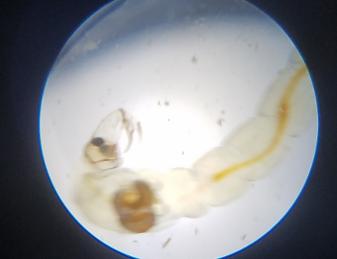
Daphnia--the go-lucky friend in the vernal pool.
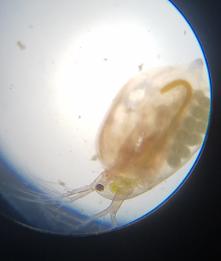
Entry 1 (2019-2-27)
It’s been a while since I was out at a vernal pool at night. When I pulled in to the empty gravel lot the air was thick with a misty fog. I donned my boot waders, camera, dip net, three flashlights, and observation tray and headed out on the one-mile trek to the back pool. As a big fan of horror films my mind couldn’t but think of the Friday the 13th movies and the serial killer movies. No worries, my aluminum dipnet will surely protect me. Luckily, I didn’t have find out.
I make it to the woods line and begin the next phase of the journey. A raccoon spots me and scurries away. Three white-tailed deer jump away. At this point every creature in the woods knows the two-legged ape is here.
The wind storm that came through a few days ago is evident with branches and limbs of trees fallen and blocking part of the path. I didn’t mark the path this year so I use a fence, old bluebird boxes, and a few large pin oaks as my guide.
I make it back. The ice is almost gone and macro life is in full swing—ostracods, daphnia, copepods, amphipods, and others. No sign of the caddisfly larva. No sign of spermatophores, salamanders or frogs. I thought for sure that they would have been tricked by the warm weather we had. I’m glad they weren’t. I did spot a young eastern painted turtle. A dapper chap with gorgeous markings with a timid personality.
While I didn’t see any sallies, the trip was not a bust. I got to be in the middle of nowhere, see cool macros, be in the woods, and see a cool turtle. Maybe next time will be the salamander time.
P.S. your intrepid explorer managed to erase all but one of the photos from this trip by mistake.
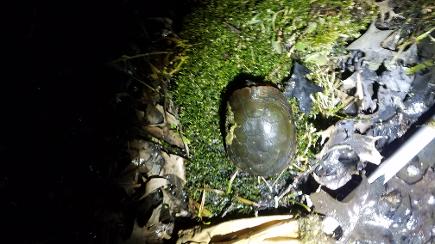
Entry 4 (2018-3-31)
The 30th was a great day to be out at the vernal pool. In the 50s, a little wind, and sunny as all get out. I led a small group of people down to a vernal pool. I’d been to this pool in the past but not yet this year. As soon as I drove up, parked, and got out I was delighted to hear dozens of western chorus frogs belting away their song. As I walked to the back of my car I couldn’t wait to don the wading boots, field microscope, dip net, and small table and set up down the hill at the pool. However, I must have patience. I arrived early to set up as I was going to lead a tour. Two people were a little early and there were a couple of no-shows. We walked down the hill and discussed the history of the location and why it is important to the Rocky Fork watershed. I explained what a vernal pool is and some of the inhabitants.
Next, I took my trusty observation tray and got a water sample. Bingo! Brown planeria, daphnia, ostracods, copepods, chironomid midge, water mites, water scavenger beetle, dragonfly larvae, and mosquito larvae. We took each one and looked at it under the microscope. I posted some photos below. We searched for one of the dozens of western chorus frogs but to no avail. It can be a futile exercise. As soon as you come close they stop calling. Move a little further and more stop calling while the ones behind you start. Sometimes its best to simply enjoy their music.
I led a second group down an hour later. Much of the same critters. I was telling them that there are small-mouthed salamanders but our chances of seeing one are almost zero. After all, it is past their breeding time and if their larvae have hatched they will be tiny. I also mention how I’ve only seen one fairy shrimp in monitoring this pool for 4 years or so. Fairy shrimp can be present one year in abundance and not be there the next. Their eggs (called cysts) can withstand the dried-out pool and be viable for decades. But I had only seen one. I moved over to a more vegetative area of the pool and took a water sample. NO WAY! What was looking at me while swimming on its back? A male fairy shrimp! It’s easy to tell the difference because the male has claspers that hang off his head and, as one of the people on the tour said, the female makes 14% less than the male fairy shrimp. So exciting—not the pay gap—but the presence of our vernal pool denizen.
After we rambled around and pulled more samples we began to pack up. One of the folks picked up my gloves and underneath them was a w. chorus frog! Three stripes down its back; hence its scientific name of triseriata. Its call sounds like a thumb running over the spokes of a comb. It was about half an inch in length—a young one! It did not want anything to do with us and kept hiding and doing it very well. After a couple of pictures (not that great ones) we let it be to enjoy the rest of the day.
Chironomid midge larva under the microscope.
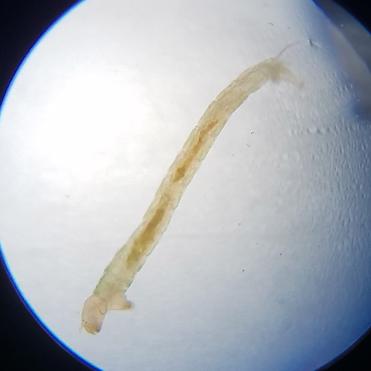
A copepode under the scope.
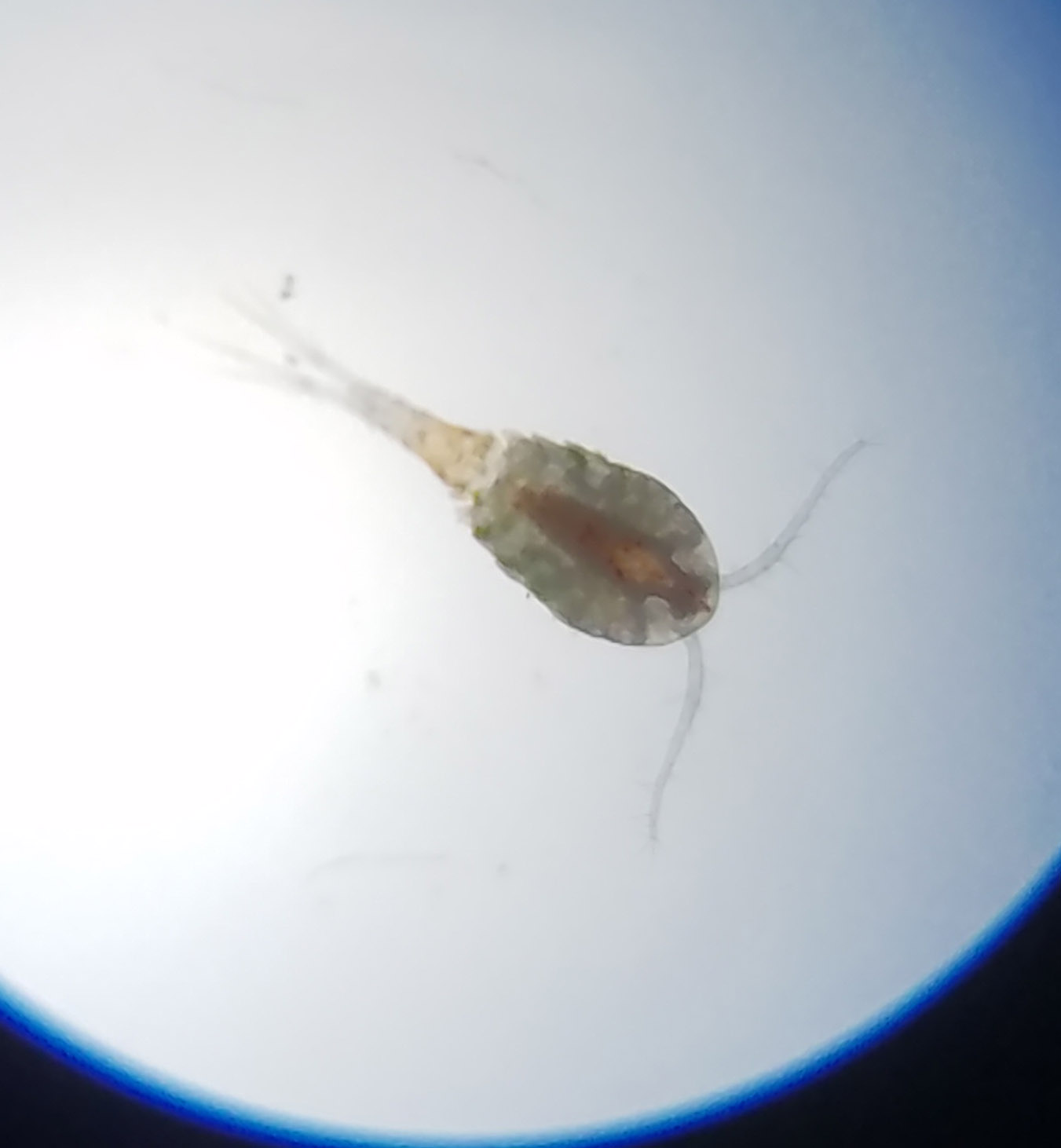
Dragonfly larva--a mosquito's nightmare!
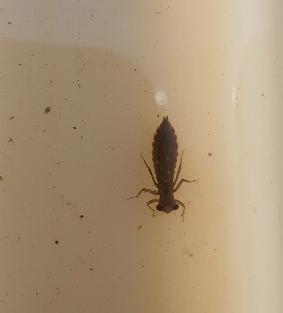
There is the special guy! A male fairy shrimp. Lots of arms to hug you with!
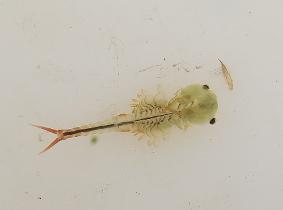
A water mite. This one is red. They can be parasitic, eat detritus, or carrion. Like me, they are awkward swimmers.
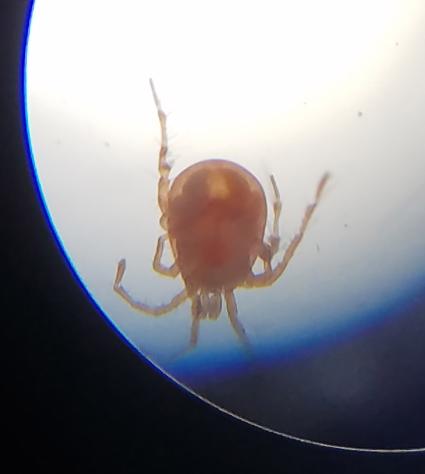
There's the beauty! Nestled in a small wooded area this pool jumps and crawls to life each spring and summer.
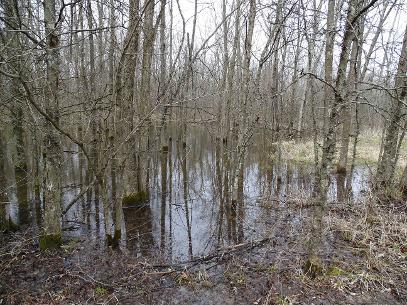
Below is the western chorus frog; about an inch and a half in length these frog calls sound like fingers over a come. This particular individual was about .5 inches long.
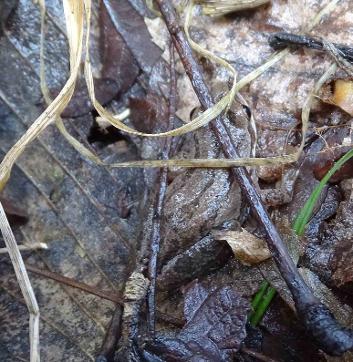
Litter. I hate litter. Found this nasty while walking back to the car. Threw it away at a gas station.
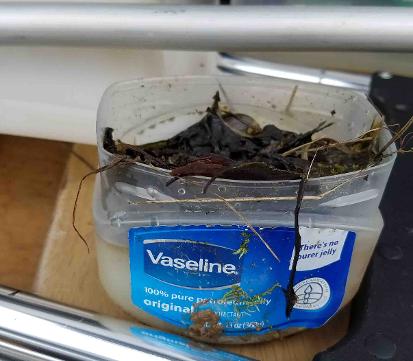
Entry 3 (2018-3-25)
The sun shining, in the low 30s, and a slight breeze; what could be better? How about 15 degrees warmer! It was a cold day at the pool this morning. Despite cold temperatures and ice the vernal pool did not disappoint. I walked back into the woods and was surprised at the lack of water, even though this spring has been a wet one. There is still water there, though, and a sheen of ice blanketed it. There are several small pools throughout this wooded paradise. I checked out about six of them and all had a thin layer of ice. Yet, macroinvertebrates are motoring away. I saw isopods, daphnia, copepods, planeria, water mites, ostracods, amphipods, and phantom midges. As I was coming back from the deep woods I decided to stop at one more pool. Boy, I’m glad I did. Looking back at me were small clumps of eggs (egg masses) of none other than small-mouthed salamanders. Given the impact this area has seen, it is a wonder that there are any left. But they are hanging on. My hope is that they survive the cold temps and we get more rain so they don’t dry out. They were also covered in some sediment which can negatively impact them. Below are the critters with commentary. Until next time, stay wet!
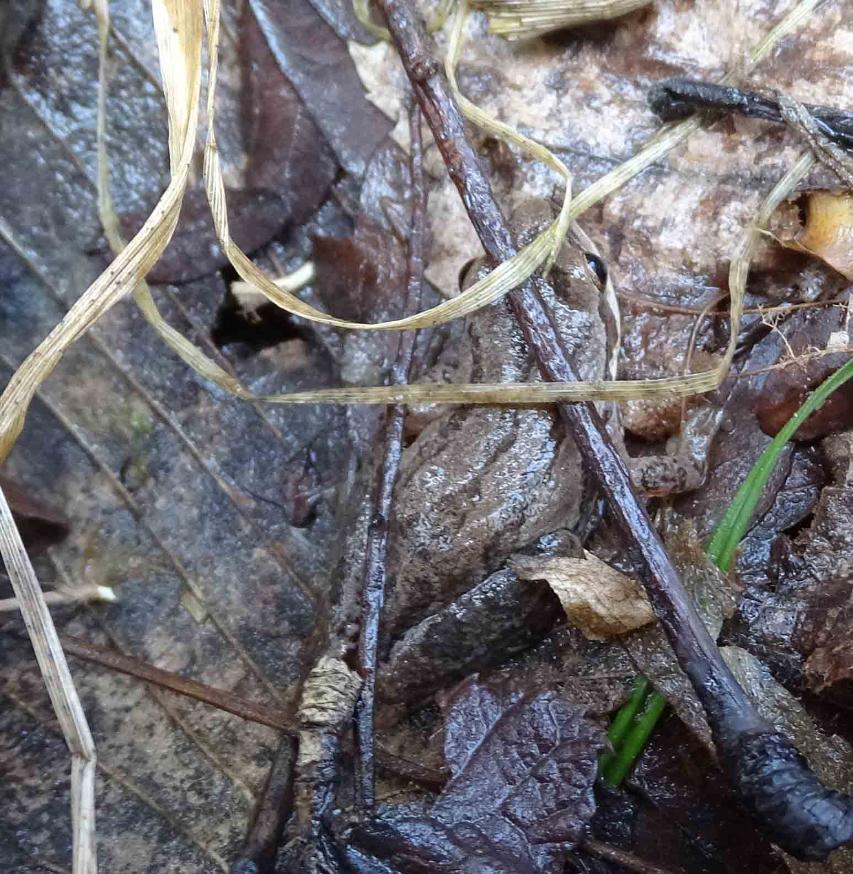
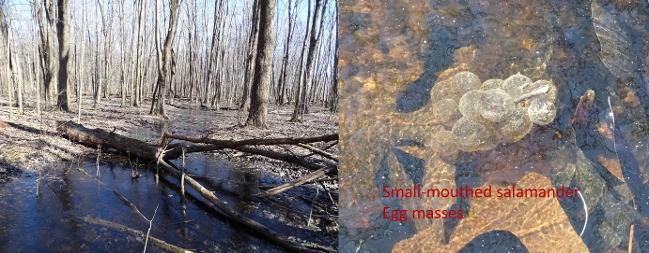
Ostracods are one of the tiniest macros. They are easy to identify because they move in a smooth motion whereas copepods start and stop. With that said, ostracods can be smaller than a period on a page. Whenever I see them moving I always think of the music to Benny Hill—don’t know why, but I do. Now, you will too;)
The daphnia. If a macroinvertebrate could hug you, surely the daphnia would be the first in line. A filter feeder, it uses its antennae to move through the water and force the water through its carapace, thus filtering out food. This one is totally prego. A cool fact is daphnia give birth to live young that look like miniature versions of the adults. The video is a different daphnia.
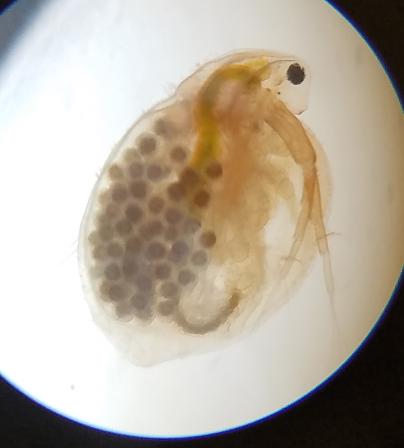
Planeria are the turtles of the macro world. Never in a hurry and they come in greens, browns, and grays. The two things that look like eyes are actually eye spots. Enjoy this video of planeria meditation.
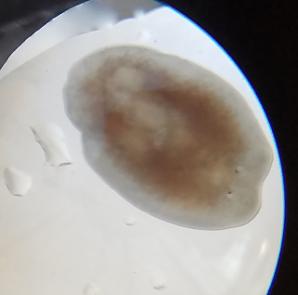
The dreaded mosquito larva. While it does serve a purpose, they gross me out. Them and ticks. This is the wiggler phase. Next it will move to the tumbler phase, then the adult. The species most likely to carry west nile virus are ones that prefer water in your gutters and potted plants.
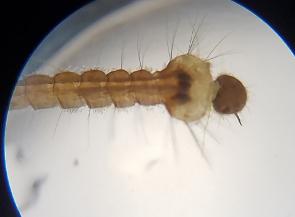
This is a glass worm, better known by its superhero name—phantom midge! They eat mosquito larvae, daphnia, and a host of other things. They have two sections that have air sacs. They can rise and fall in the water column by inflating or deflating the air sacs. Enjoy.
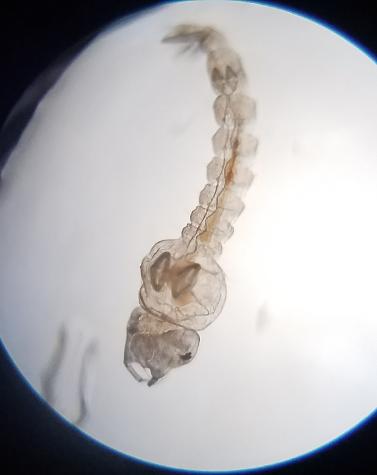
This was the first caddisfly larva I’ve seen at this vernal pool and makes me very happy. They are kind of sensitive critters. This one was tiny, but made a big impression.
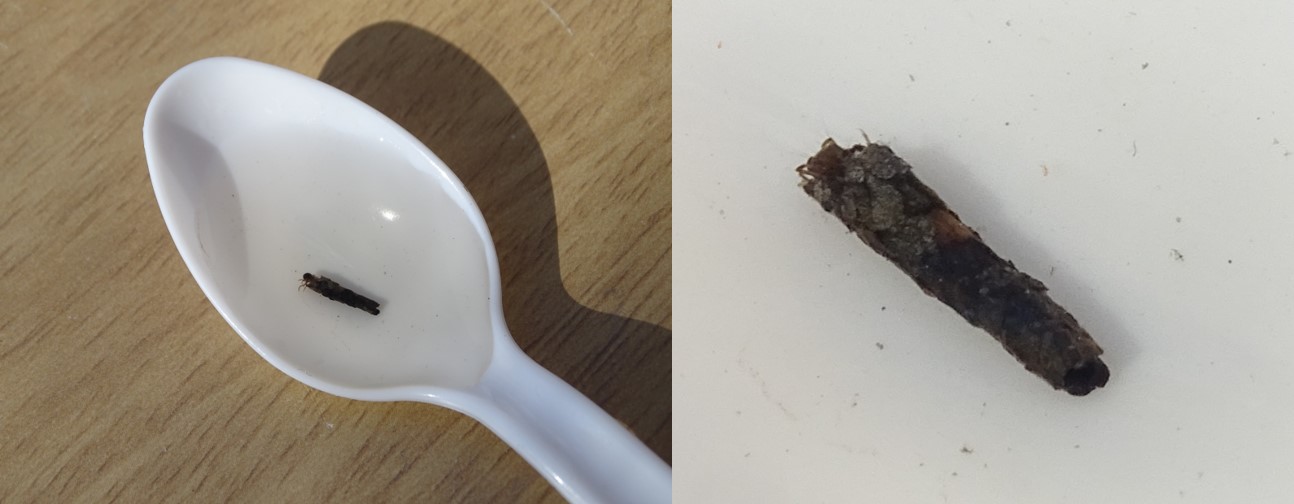
Copepods are always so fascinating with their colorful egg sac and stop-go-stop motion. I believe this one is the cyclops species, but someone correct me if I’m wrong. There is also one without eggs.
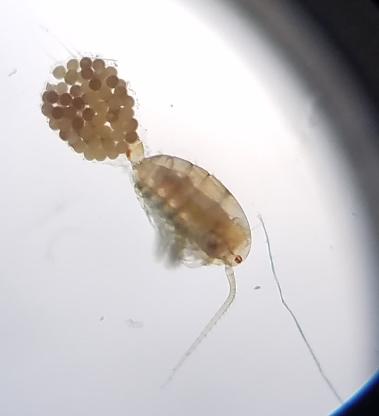
Entry 2 (2018-2-19)
What a difference a few days makes! Before I the ice was thick enough to support my weight. Now it has all melted and the pool is deep. I walked along the western portion not knowing what to find. I was out here several years ago and was surprised to see spotted salamanders. Are they still here? As I walked slowly piercing the darkness with my flashlight, I noticed scavenger beetles darting up to grab an air bubble then headed back into the messy floor of the pool. Crayfish propelled themselves backwards to distance themselves from the two size 12 wading boots making their way around. Isopods crawl on a purpose to shred and procreate as much as possible. A couple Canada geese take flight—I feel bad about this one. I don’t want to disturb them at night and tried not to encourage on them, but I failed this night. As I keep searching, I see what I think is a spotted blur. It is! But I was too slow it has gone to the depths. I continue my march. Yet another one! This time I wave my trusty dip net and gently scoop up the hero of the night—a spotted salamander. I say hero because this pool is near Interstate 270 and there are not very many spotteds here. I take Mr. Spotted out and get his picture. I’m pretty sure he is a he because his cloaca opening is swollen with spermatophores. The males get to the pool first lay down the spermatophores on leaf litter and wait patiently for the females to show up. Then the male tries to convince the female to walk over the spermatophore and pick it up. This is where the spotted salamander dance comes from. I will not demonstrate what it looks like. After I put this guy back I walk further and lo and behold a smallmouthed salamander!! Wow, this is a big night for sure. I take more photos and gently put him back in to the pool. I get back to my car pumped and head home.
Smallmouthed salamander in hand. Notice the swollen cloaca (near base of tail). It will lay spermatophores tonight.
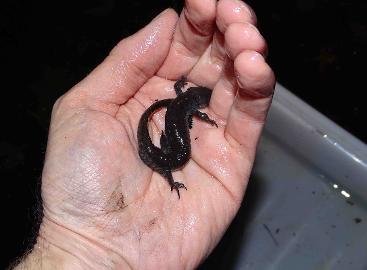
The state's amphibian--spotted salamander! The video is below as well.
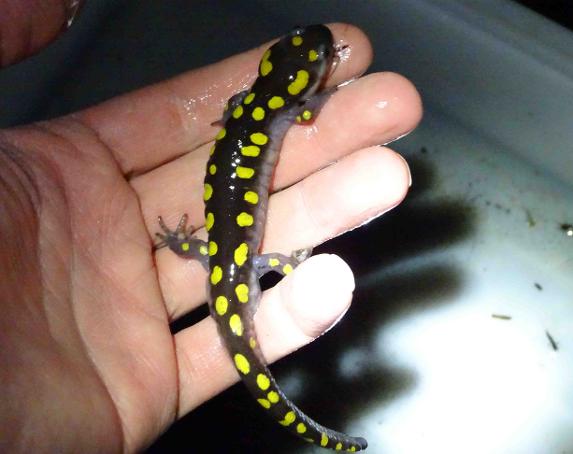
Entry #1 (2018-2-14)
It is Valentine’s Day and what better way to show the love then out at a vernal pool! Ok, so that didn’t go over so well. The day was warm and rainy, but the pool still had enough ice to support my weight—191. I did see some isopods crawling in the one-inch layer of water between the ice and the air. Also, some copepods. I couldn't lay out the funnel traps, but still good to be getting back out and the front end of the season!
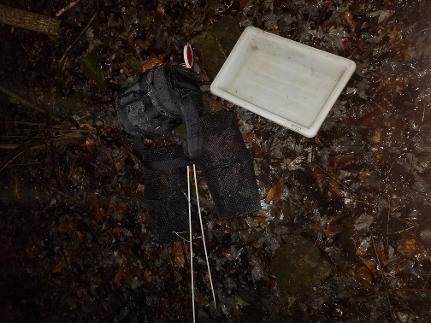
Entry # 14 (2017-10-22)
I'll post a better description later, but things are still crawling and hopping around in the vernal pools. These particular pools don't really dry up each year. They still have a decent amount of water in them. Below is some video of the creatures witnessed that day.
Entry #13 (4-302017)
Trees are blooming and leafing out; mayapple is in bloom (in April!), and gray tree frogs are marching towards the vernal pool. I led an expedition of a couple folks over the weekend to the small wooded vernal pool. After about ten feet into the woods we came across a friendly face—a gray tree frog sunning itself on some mayapple. What a way to start an expedition! After dozens of photos were taken we gave it a wide berth and headed deeper into the sun-drenched woods. The spring beauties are living up to their name and the poison ivy is reminding us how prolific it is (despite being a pain to people, poison ivy berries are great for wildlife). It seems like every tree is greeting us with a high five with its leaves. After about 15 minutes we spot water. We set up the microscope, table and take a minute to soak in the beauty of this vernal pool.
One peers over the water and it is rippling with life. Thousands of tadpoles and salamander larvae come up for air and make tiny ripples. We do a couple of scoops with the observation tray and come up with a dozen tadpoles—not sure the species--, a few daphnia, copepods, water scavenger beetles, ostracods, and dysticid beetle larvae. Oh, and a couple of backswimmers. What was noticeable was the lack of mosquito larva and not too many adults. Reason being this is a high quality vernal pool which is a predator-rich environment.
This gray treefrog is relaxing and soaking up the sun while it rests on a mayapple flower. A color changer, it can change from green to gray to brown pretty quickly. It's call is a rapid fire sound that is unique.
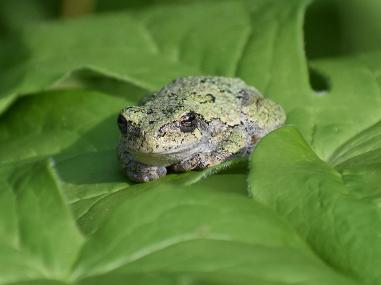
Here be dragons. This salamander larva has external gills which give it a dragon-like appearance. A fierce predator and positive indicator for this vernal pool. Two thumbs up little dude.
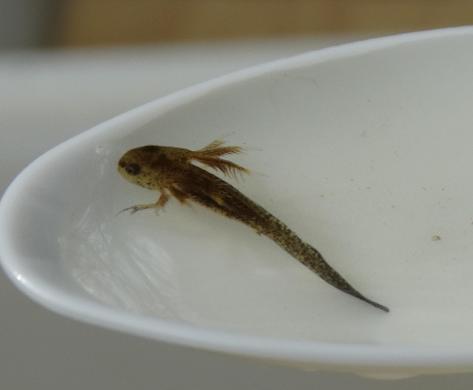
Here is a tree swallow. Gorgeous and quite the aerial acrobat. It needs to be in order to catch insects.
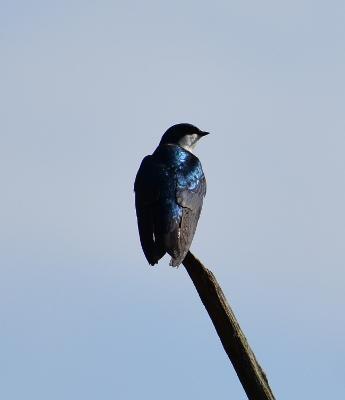
Entry #12 (4-8,13-2017)
KER-PLUNK! That is what I heard the other night around 9:30pm deep in the woods bent over looking at macros in a vernal pool. I immediately looked up and saw the water swirl about ten feet away. I shined my light beam to the location, it pierced the water, but nothing. I stood up and took a couple steps closer and still nothing. I didn’t want to go any further because the pool is acting like a “nursery” at this point and thousands of tadpoles and millions of individual macros are motoring around. So, I step back to wet land. My guess it was either a large bullfrog (unfortunately they are back there), snapping turtle, or monster.
The peepers are still calling; the American toads, are arriving as are the gray treefrogs. Even a northern leopard frog was spotted (but not heard). They are neat frogs to watch. During the day I did see a salamander larvae! It still had the balancers on it (they are located off the head on both sides; they’ll usually fall off in a day or two). They have the external gills which make them look like little dragons with an appetite to match. Anything they can fit in their mouth they will try and eat.
The other week I had the honor to present on macroinvertebrates at the Ohio Wetland Association’s NE Ohio Vernal Pool workshop. I had a blast. 40+ people came out to hear about macros, ecology, salamander, plants, monitoring technology, and got to visit two very high quality vernal pools. I even saw my first four-toed salamander! They are called that because they have four toes on their back feet. They lay their eggs in the tussocks or sphagnum moss. Once ready, they’ll drop into the vernal pool. They are 2-4 inches in length, so a great find by one of the participants. I videotaped my presentation. It’s not the best angle, but you can still hear about macros and see some videos. Ohio Wetlands Association is holding a vernal pool trip on May 13th over in Gahanna. For more info on that check out OWA’s website.
See below for photos and video.
This is a northern leopard frog. Beauty of a frog!
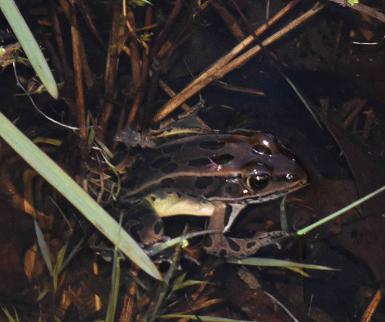
All those are tadpoles. Must be thousands!
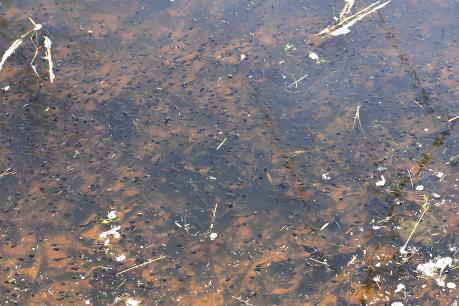
A salamander larvae friend. Notice the balancers off the head (can really only see the left side one).
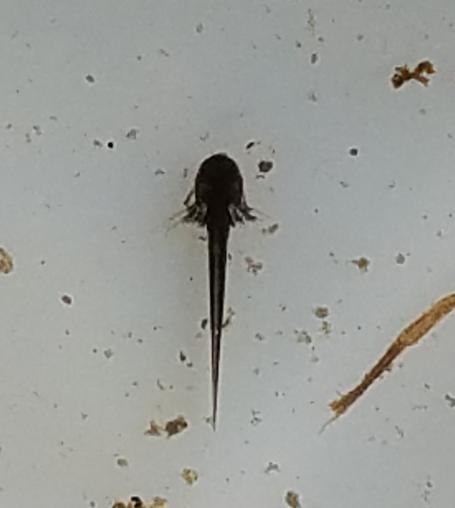
The three pools I'm monitoring have thousands of spiders. This is the six-spotted fishing spider. When you look like that you don't need a pole to go fishing.
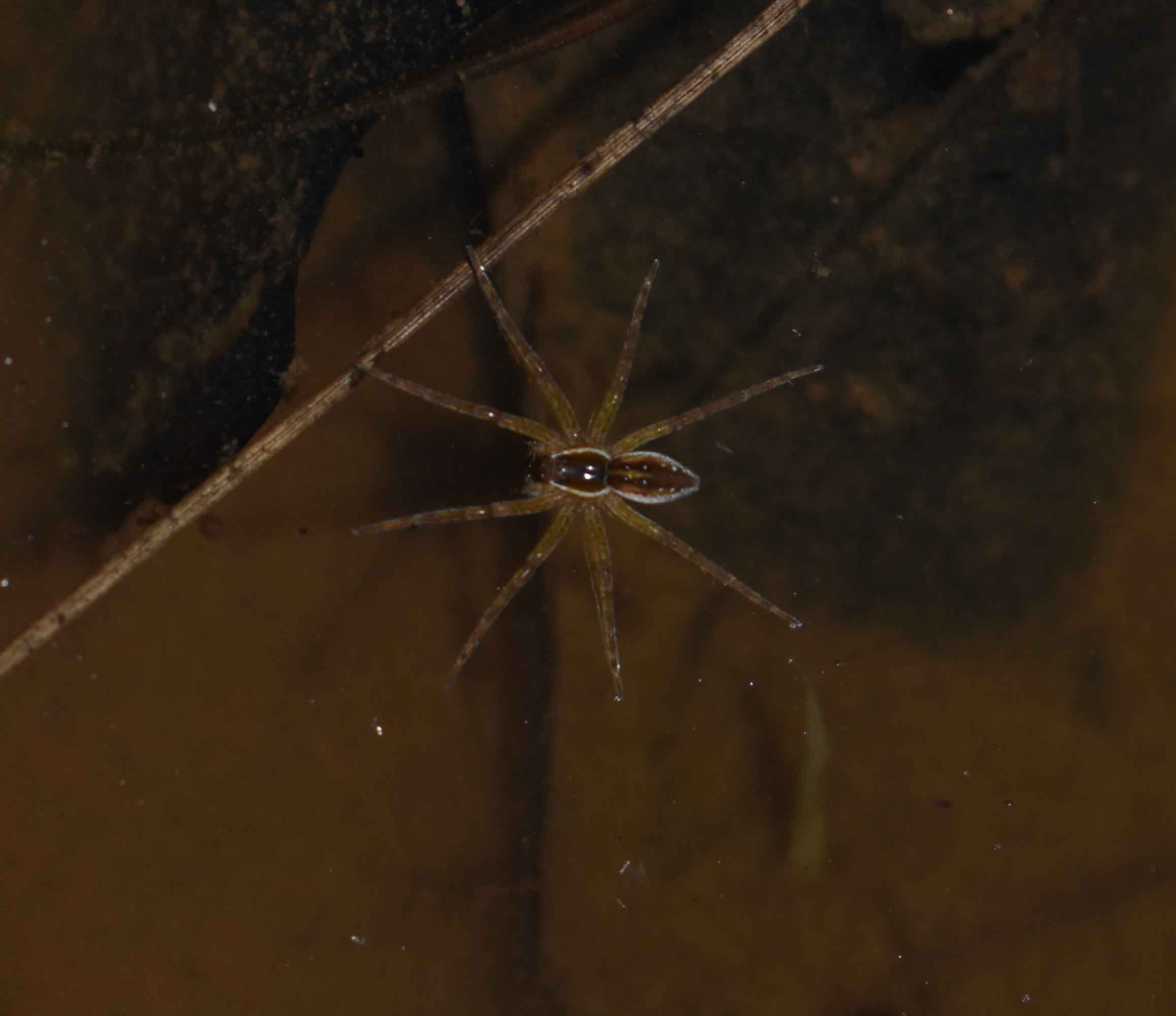
This is a dysticid beetle larva. They are also called water tigers and for good reason. They are quite the predators.
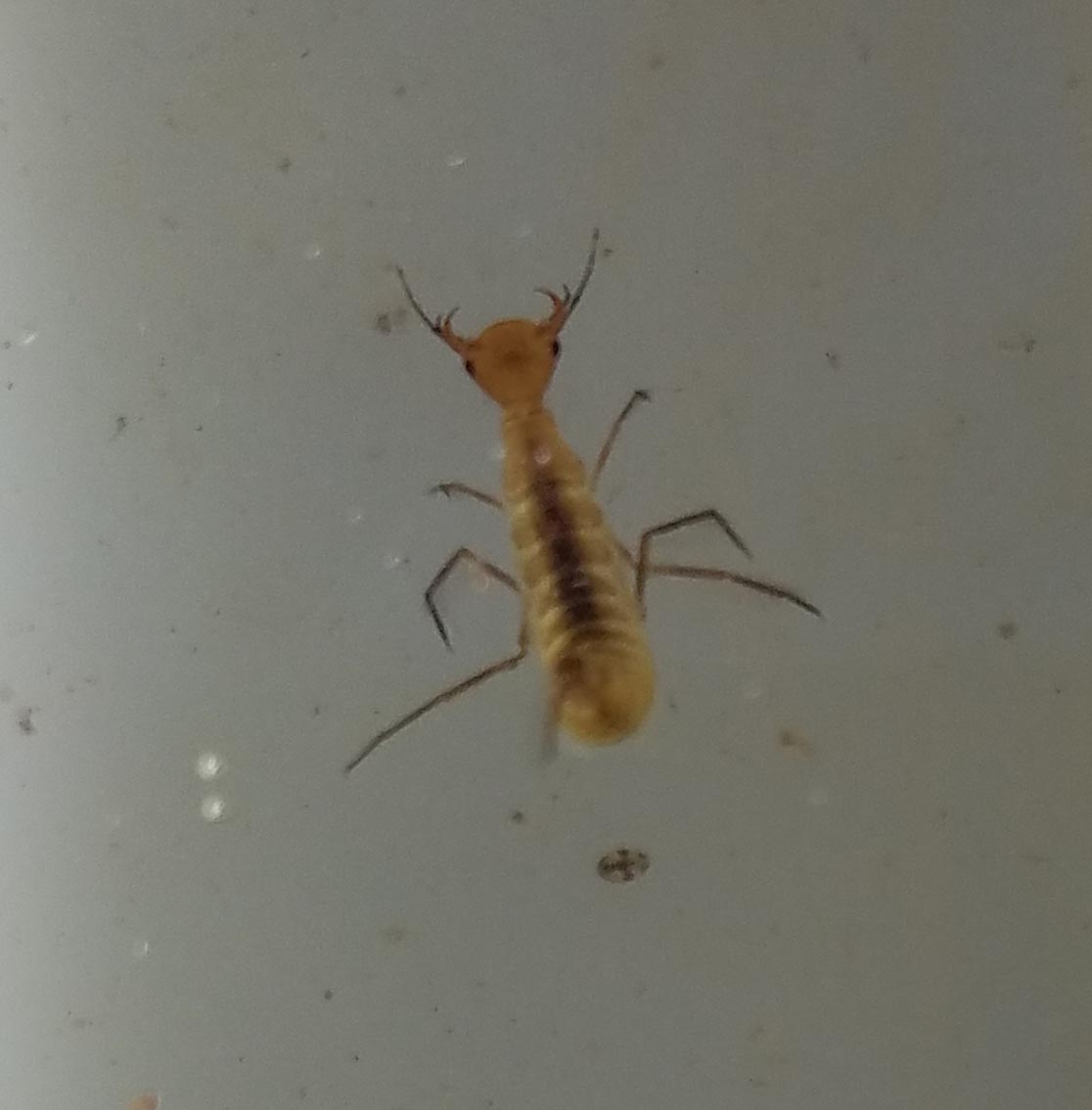
This tiny salamander is a four-toed. They have four toes on the front and back legs where other species have five. State listed as a Species of Concern (two steps away from endangered--let's hope it doesn't make it there). To the right is a photo of their eggs.
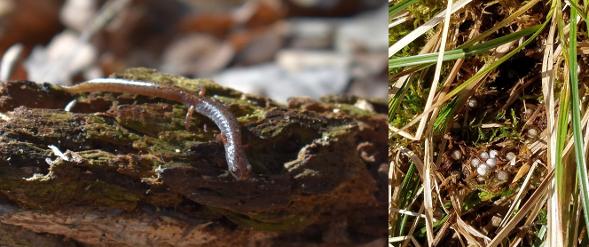
Below is my presentation that I gave at the Ohio Wetlands Association's NE Ohio vernal pool workshop. Lots of fun!
Look at all the tadpoles!! P.S. make sure you watch in high def). All ripples in the water are from the tadpoles.
Entry #11 (3-25-2017)
What? I can’t hear you! That is what it was like being out at the vernal pool last night. Like a high-pitched guitar solo (only better). 1,000s of spring peepers trying to find love and creating a deafening chorus (have pounding headache today). But it was worth it. Others that were being over shadowed by the call of the peeper include Northern Leopard frog, w. chorus frogs, American toads, and wood frogs. Leopard frogs sound like a snore, or like the noise the creature in the movie Predator (yes, that one) sounds like. They make their call while semi-submerged in water.
I was surprised wood frogs are still calling. They sound like evil elves laughing at you (or like a duck). The area I was in has several vernal pools and the wood frogs have made their way up to all of them; this was not the case a few years ago. Goes to show you that if you build it, they will come. No salamanders on this expedition, but I did see a ton of egg masses (sweet!)
The wood frog is a superhero of sorts. Sporting a black eye band and being able to freeze to survive the winter, they are certainly hardy animals. They do require 100s of meters of forest to have a healthy population. Instead of the gular pouch (the part on a frog that inflates when calling) being under the throat, theirs are two that go off to the sides.
The macros are still out in force, although the daphnia numbers have plummeted while ostracods have increased and caddisfly larva are still crawling around. Even saw a green water mite—see below for video of this quick dancer.
Next time I will bring ear plugs to preserve my hearing. Truly one of nature’s greatest experiences.
Forget the mask--this dude has a cape!
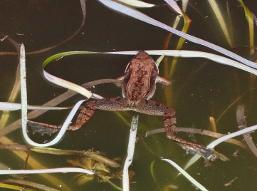
A couple of western chorus frogs hook up for the night.
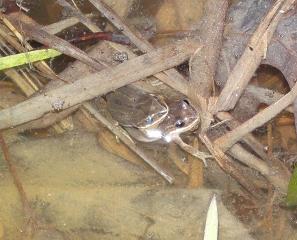
Egg mass among the vegetation. When out in the vernal po0l be careful where you step. Also sediment you kick up can damage the eggs.
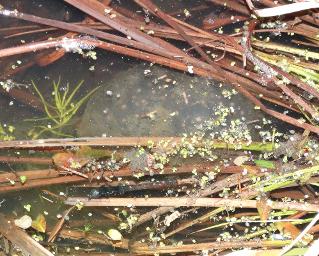
Backswimmer on his/her back. Don't touch! They'll stingthe dickens out of you.
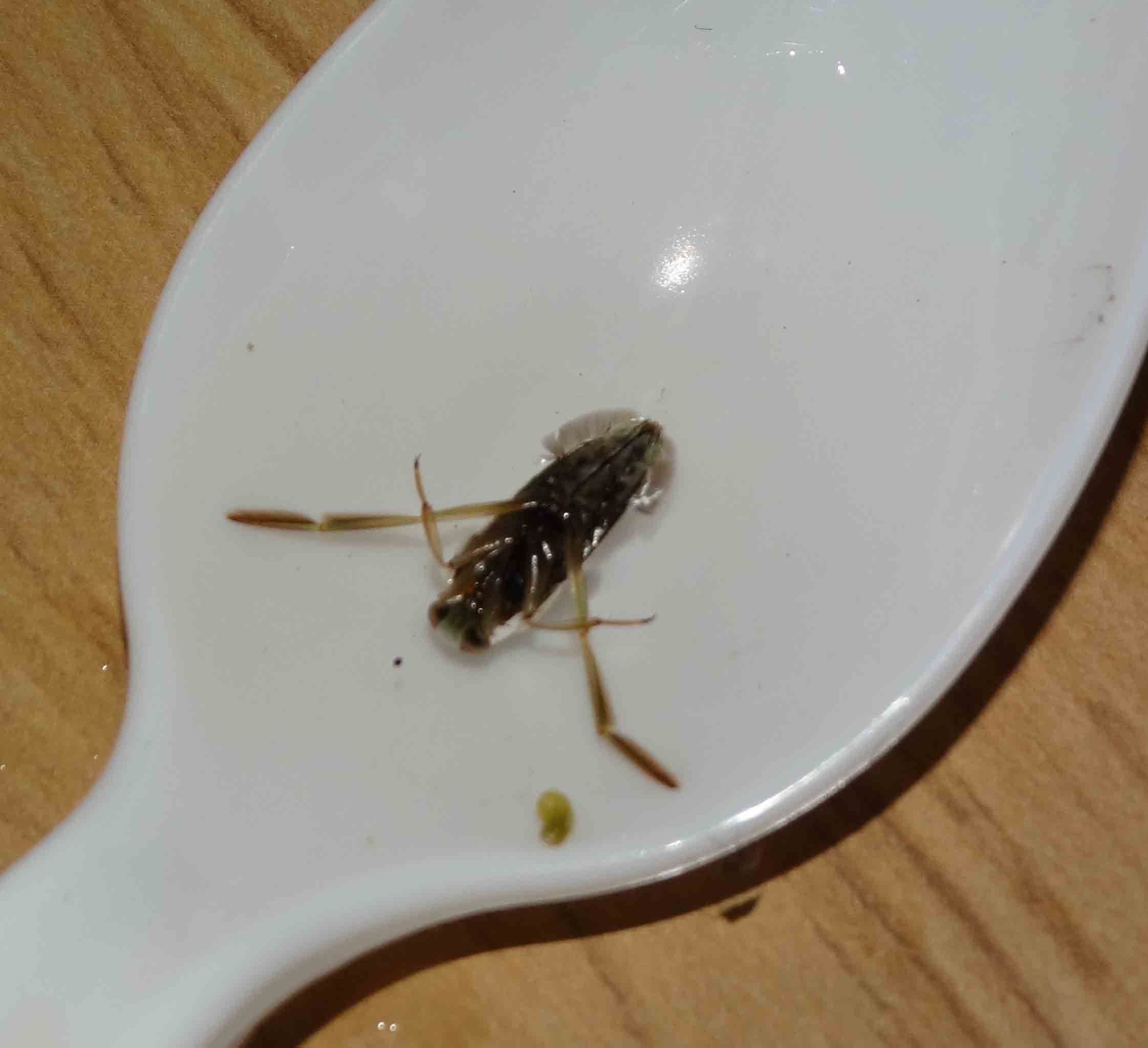
How many spring peepers can you find in the photo? This is less than a 3 foot square area.
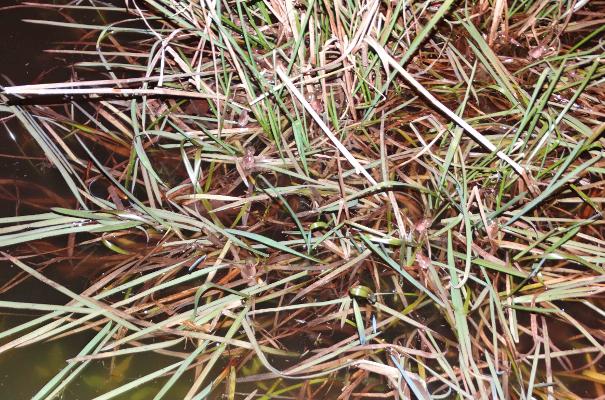
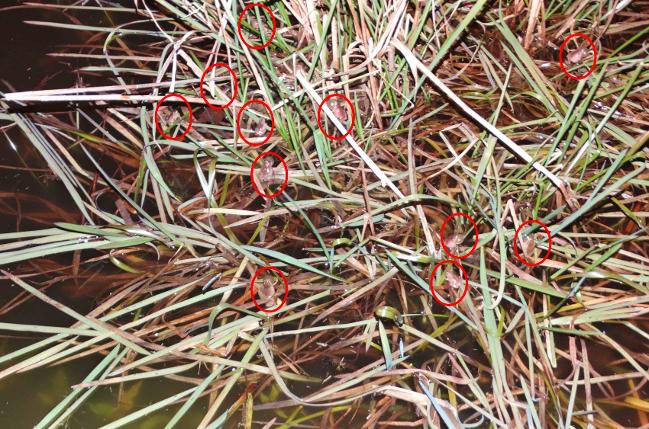
Green water mite!
The thing on the left is a mosquito larva (itchy, itch), the thing on the right is a phantom midge (macro hero that eats mosquito larva).
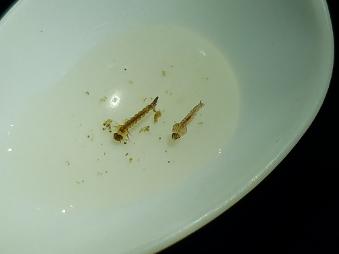
Ostracod in motion.
Thanks to Mr. Jack for snapping this in-situ photo or yours truly. When out in the pool, the critters don't care what you wear.
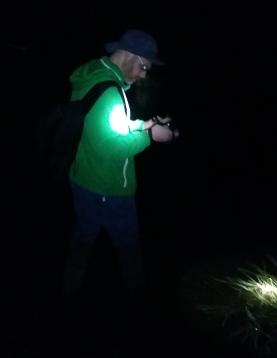
Entry #10 (3-1-2017)
Went up to the pool this evening. The description: I arrived after dark. Wind swirling about but not suggestive enough to warrant abandoning the expedition. I slide the wading boots on, slungmy camera bag around to my back, pick up the tripod and start the 1 mile walk. The first half mile isn't too bad--flat ground on paths. I extend the first legs of the tripod just in case unfriendlies show up. You see last time out at night Meredith and I hear the sounds of banshees-also known as coyotes--that were pretty close. So before I get to the tree line I can only think of that scene from American Werewolf in London (the original) where the pub dudes say "stay off the moors" and they don't and get attacked by a werewolf and then turn into one. I don't want to turn into a coyote--definitely not as cool.
Peepers are calling despite wind and dropping temps. A hearty breed of frog they are. They deserve all the respect you have to give.
I make it to the tree line and start the rest of the expedition. The marking tape is still up --yay! I won't have to spend 30 minutes wondering aimlessly in the woods trying to find the pool.
I stop at the small pool. I'm glad I did.Peepers still calling and a couple western chorus frogs. I look into the still waters and see water scavenger beetles, water mites, and fairy shrimp. The f. shrimp are of varying sizes. Some that are incredibly small-baby f. shrimp (technically called nauplis). While I was filming the shrimp a spotted salamander came up for air about a foot out of frame (would have been too perfect if I caught it in the shoot). Next I see a smallmouthed (or Jefferson) salamander glide through the still water headed towards the deep end. I make my way to shallower shores as I was kicking up a lot of sediment which can harm spermatophores and egg masses. Also kicking up sediment is being a real jerk to the macros and I don't want to do that since I'm in their home.
I shine my beam of light behind me to see a wood frog eyeing me. I don't think I was in danger of getting amplexus put on me. Very excited to see one of these masked avengers in this pool. They usually only stay at the vernal pool party for about a week. I also spot some egg masses. Most likely smallmouthed or Jefferson. The mighty sycamores, pin oaks, and spiky trees provide good protection to these amphibs while they call.
I get some video and photos of the various residents (nothing turned out super) and pick up the gear and head to the back back pool (uber high quality). Only what do I hear right before I get there? The faint howling of coyotes. I had my tripod and big knife with me but decide to err on the side of caution and turn back.
While headed back the wind picks up and it begins to hail (hail no!). I pick up the pace the best I can with my dumb knee. My thoughts turn to where to go in case I see a funnel cloud. The housing development close by? "There is some strange guy talking salamanders who wants in!" Dive to the bottom of the pool? Don't think 1.5 feet will do much to protect me. Maybe head to the car and hope for the best. Surprisingly peepers are still calling (they have a one square foot territory in which they call from). The hail got to be a little smaller than a pea. I make it back to the car, change footwear, throw gear into the passengers seat and head out. Here's a photo of a spotted salamander back side.
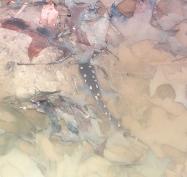
Entry #9 (2-20--26-2017)
Did three vernal pool sites in two days. It was a lot…of fun! Disinfected gear after each visit. But what a difference a few days make. I was out in the pool on the 20th and back on the 25th/26th. There was a 40 degree difference. On top of that, someone took down my marking tape to get to the back pool. Added 40 minutes to our travels. Not fun. But we did make it back there and did get some shots of the spotted salamanders (a bad photo/video is better than no video). These troopers come back to the same pool year after year to breed. They are there for a week or two then head back out to the woods. We also saw Jefferson salamanders (no photo). They are slightly smaller than the spotteds and seem to run with them during the breeding season. Wood frogs and w. chorus frogs made their presence known. No pictures of those this year…yet. So did the peepers. They were sooo loud; 100s or 1000s. Ears ringing! “x” marks the spot for the peepers. They have a one-square foot territory and call in trios. In another pool we saw spotteds AND smallmouthed.
The other macros seen at the various pools were pretty cool. Below are photos of them with brief descriptions.
Smallmouthed salamander with insert of their eggs.
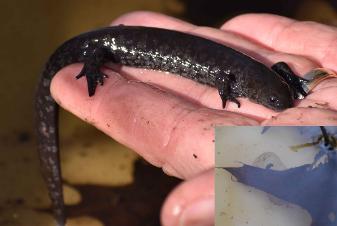
Here are some spotteds. Spermatophores are what the males lay on twigs and leaves on the bottom of the pool. The females show up and the male does his dance to try and get the female to walk over the spermatophore and pick up the top part with her cloaca. BTW notice how the one spotted does not have very many spots.
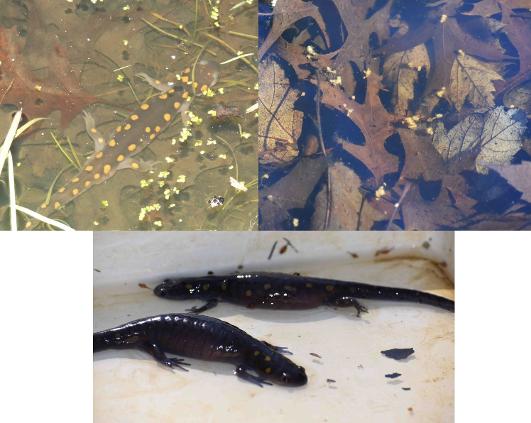
Fairy shrimp adult! This is a male in a spoon. Either bundyi or neglectus. The male will use his claspers (trunk-like appendages) to hold onto the female. They be like this for hours or days. Once mating occurs the dude goes off and dies somewhere. A tough life, but why not go out on top?
I know, I know, another copepod photo. This one has the two egg sacs (cyclops). They can be found in almost every vernal pool. They race against time to life out their life cycle. The eggs survive the dried pool by either dry-resistance or encasement.
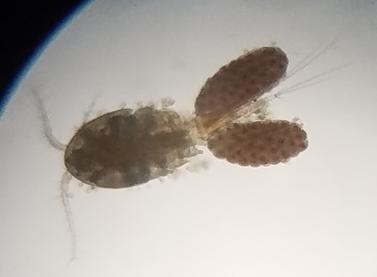
Chironomid midges are pretty fascinating to watch as they use a “figure 8” motion to propel through the water. The hemoglobin in their blood which gives them that red look. They are known to develop soft tubes that they retreat to. In summer they will all emerge around the same time and it is a site to see. In a sense it is a different type of migration than the spotteds.
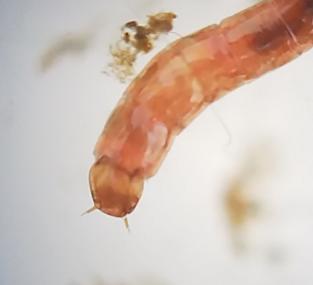
A water mite. They are fascinating creatures that have several stages of life. Some are parasitic. They are arachnids.
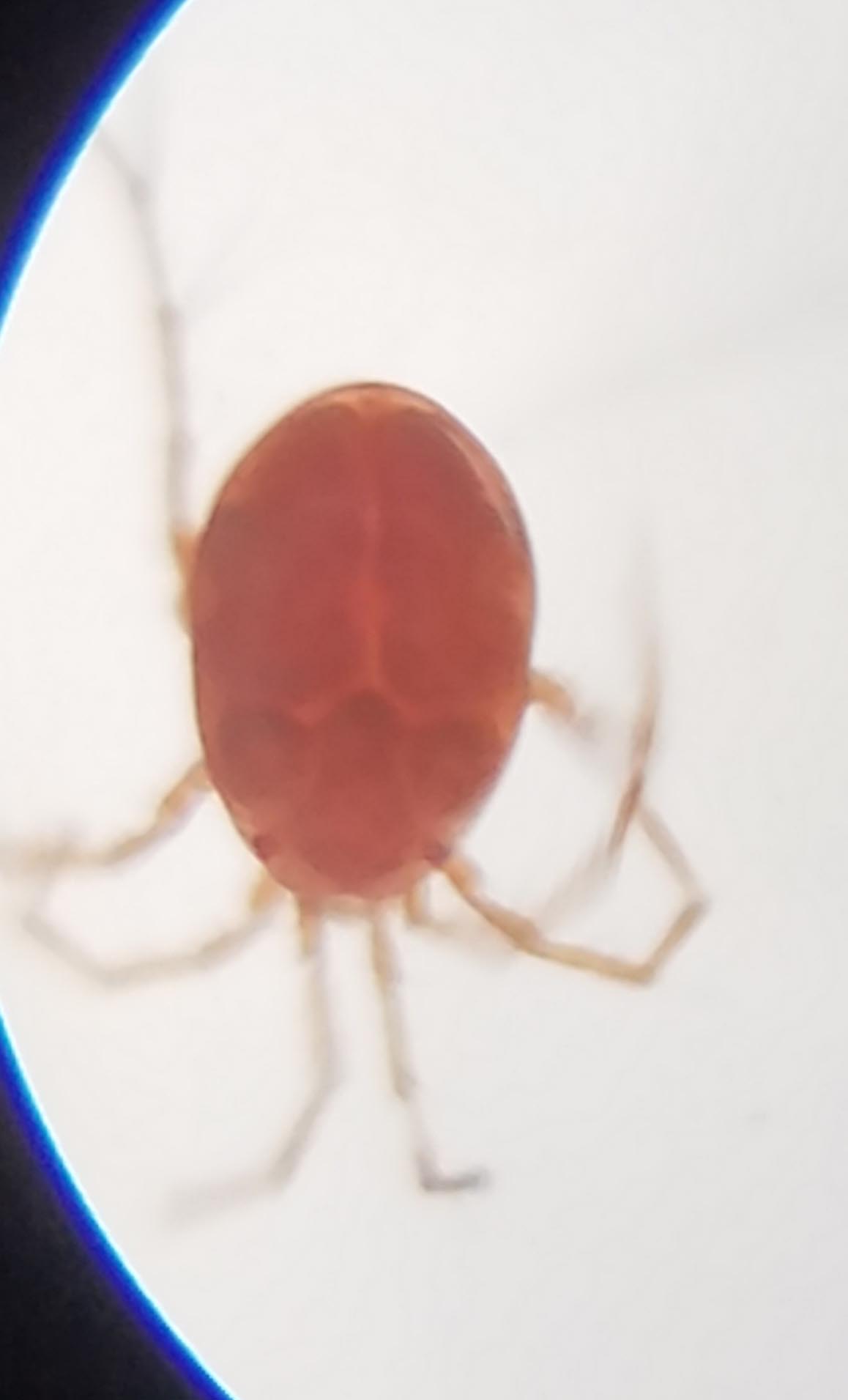
The last macro for today is the intriguing phantom midge. Almost completely translucent, you really have to look for them this early in the season. They main feature is the two air sacs that act as ballast to move up and down the water column. While they look huggable, they are quite the predators. Antennae evolved into hooks where they will grasp prey (like mosquito larva) and pierce it with their beak. I hear there are two main species here in Ohio. The second picture is of it upside down--notice the antennae!
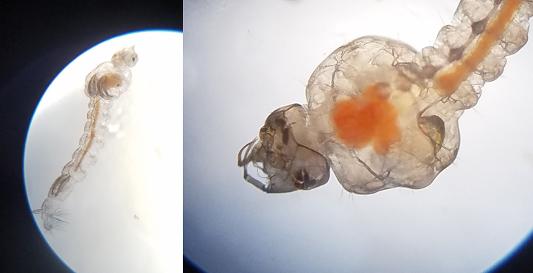
Ok-I did see a spring peeper! Notice the 'X' on its back? That is one of the distinguishing features; the other is the 'peep' sound it makes.
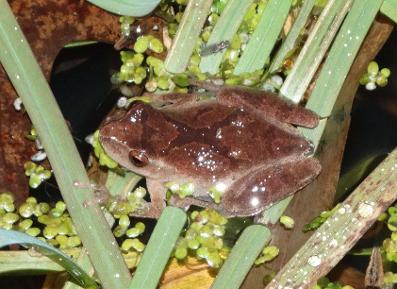
Entry #8 (2-18-2017)
Another week, another trip to the pool. I headed back to the “backpool” and it gave up several of its secrets. I had not really monitored this one in the past because there is a higher quality pool not far from it. In the past, the sampling didn’t reveal much. But it is exciting this year.
I’ll start out with the whopper of news. It has fairy shrimp! Why am I ecstatic about this? Because fairy shrimp are an indicator species of decent to high quality vernal pool. Also, this pool is in a network of about 4 and I’ve never seen fairy shrimp before here. How did it get here? Well, the fairies have a number of ways of traveling. Their eggs (called cysts) can be ingested by waterfowl, pooped out, and still be viable. Waterfowl will eat the adult fairy shrimp. The cysts remain in the soil for decades and are still viable. Given the right conditions only about 3% of cysts will emerge each year. The one below is in the Nauplius stage. It will grow through molting and gain length of about an inch. The main species in Ohio are bundyi, holmani, and neglectus.
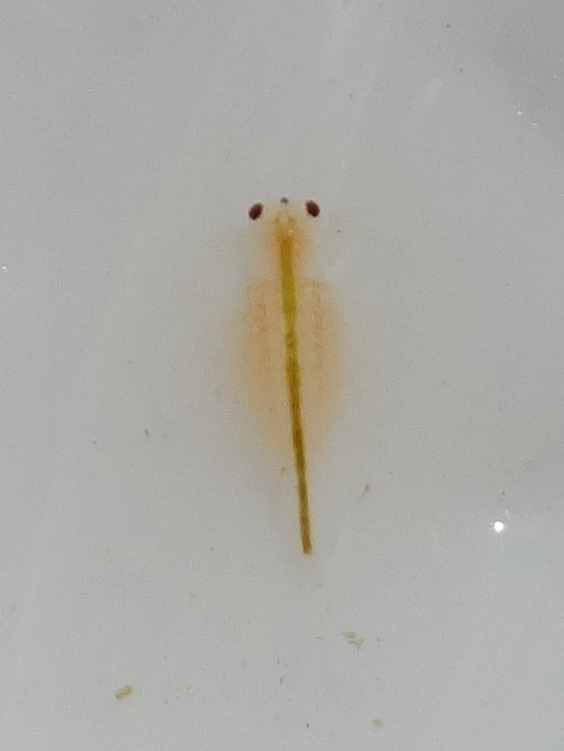
Our second friend of the day is the crawling water beetle. They have a friendly gait with an easy disposition. They do require air and are well evolved for this. The outer wings have very tiny holes in which it can store air pockets. You see two air bubbles in the picture below. They are herbivorous. Always a pleasure to meet one of these critters when in the field.
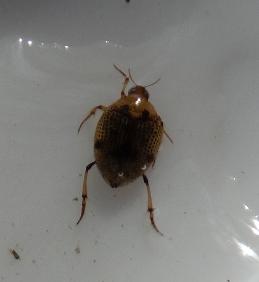
Next up is the water scavenger beetle. It is aptly named since it feeds on decaying organic matter. It is part of the recycling crew of a vernal pool, but “water recycling beetle” could confuse some folks, hence its name. They seem to be on the move all the time.
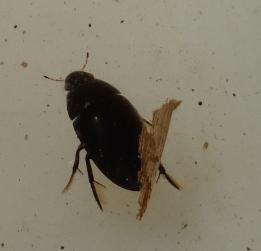
Here is a copepod with eggs. I believe it is the harpactoid species. It is a colorful species that plays a key role in the vernal pool: food. It falls prey to a number of larger macroinvertebrates. On the flip side, copepods can be carnivores, detrivores or herbivores. When you pick up a sample of water wait a minute for it to get still. You’ll be surprised at how many tiny things start moving around. Chances are copepods are one of those.
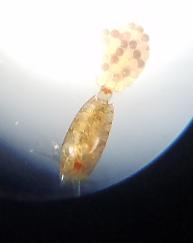
The ever-present daphnia are not only cute, but contribute to the overall health of a vernal pool. No natural predators, this sprite of the vernal pool comes out in big numbers. When ice covers the pool some predatory macros and other predatory animals can’t get to the daphnia. This allows the daphnia to party it up and make bug numbers. They give birth to live young that basically look just like them. They propel through the water with their antennae. This creates a current through their carapace and they filter out even tinier organisms. They have a stop-and-go type movement.
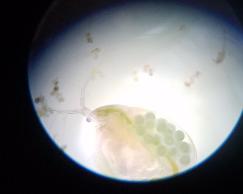
The amphipod is a scuttlebutt. It scoots around the bottom of the pool looking for decomposing animals and detritus to nibble on. They come in a host of different colors (I don’t know the reason, but I bet they do). This one is very small.
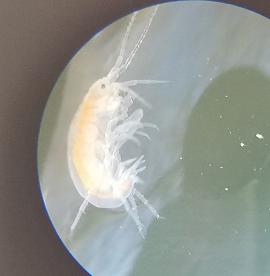
I did end up going to the back-back pool which is not far from the back pool. This pool is the one where I saw two spotted salamanders last week. While I'm better with the wildlife, it wouldn't be here if not for the flora. This is some sphagnum moss hugging a sapling. Many creatures can be found living in this type of moss. One day I'll check to see if the elusive four-toed salamander is there.
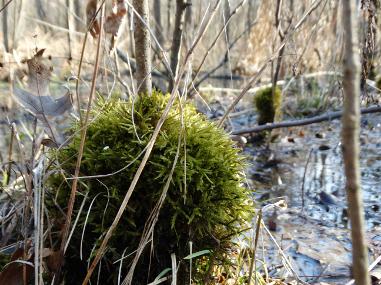
Entry #7 (2-2017)
I'm back! Hope you all had a great winter season. The winter here in central Ohio has been anything but. Unseasonable warm weather meant migrations earlier than usual. I cleaned off the gear and started the season off right. I saw a smallmouthed salamander swimming under ice at the beginning of February. They usually migrate mid-February, so a few weeks early for them.
The smallmouthed salamander has just that-a small mouth. Its toes are stubby and head small. Its closest relative is the streamside salamander. They diverged about 4 million years ago. One of the smallest of the mole salamanders in the area, they come out early to get a head start on mating before the spotted salamanders move in. Throughout the year the samllmoutheds will live underground, under logs and rocks. They don’t venture too far from the vernal pool. The males arrive first and lay down their spermatophores-little packets of DNA. Once the females arrive the males try to get the females to pick the top of the spermatophore up in her cloaca. Internal fertilization happens and she then lays clusters of eggs on twigs, leaves and the like.
While sort of clumsy and slow on land, smallmoutheds take off under water. Graceful and sleek, their prey better watch out.
I also saw some copepods (even two that look like they are mating, isopods, and planeria. I did see a daphnia, but didn’t get its photo. At one pool there were 2 spotted salamanders spotted (ha!) but no photos were taken. Below are photos/video of the creatures seen at these two vernal pools.
Smallmouthed swimming under ice.
Copepods doing their "copepod dance."
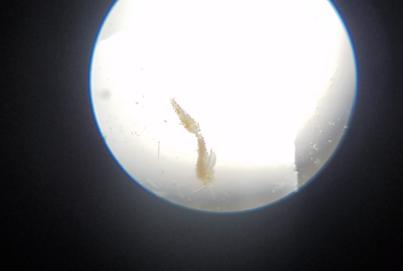
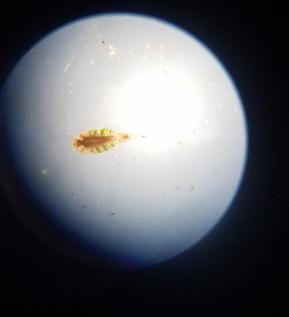
Planeria doing the planeria slide. Notice the two eye spots.
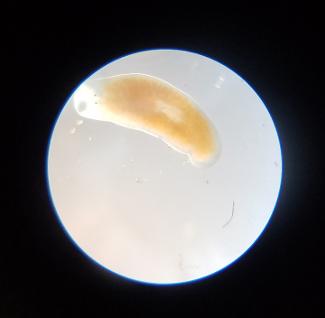
Isopod. They are detrivores and hang out on the bottom of the vernal pool.
